
How much exercise does a dog need each day? A general rule is that most dogs need 30-120 minutes of exercise per day, although a healthy amount for your dog depends on their breed, health, age, energy levels, and other factors.
In this guide, you’ll learn why exercise is important, how to estimate how much your dog needs, and tips for both physical and mental stimulation. We’ve also included common dangers when walking and extra tips from veterinary surgeon Dr Linda Simon. So, let’s get started!
Disclaimer: Always check with your vet before starting a new exercise program. Your dog’s health history, breed, age, and current health problems affect whether a certain type of exercise is safe.
Contents
How Much Exercise Does Your Dog Need Each Day?
As a general guideline, a dog should spend at least 30 minutes to 2 hours exercising each day. This doesn’t need to be in one go. In fact, it’s usually better to split exercise into several sessions to avoid over-tiredness.
The right amount depends on your dog’s age, health, breed, and other factors though. Here’s an overview of some of the key considerations.
Breed Type

All breeds need exercise to relieve stress and improve well-being, but the amount varies greatly.
Breeds with high energy, such as Labradors or Border Collies, need up to two hours of exercise daily.
Lower energy breeds, such as Yorkshire Terriers, Shih Tzus, and English Bulldogs still need exercise, but they can make do with around 30-45 minutes per day. One or two short walks and some indoor games is usually plenty for these dogs.
The table below gives some guidelines for how much exercise many popular breeds need. You’ll need to adjust the time depending on other factors though (see below).
| Breed | Daily Exercise |
|---|---|
| Bichon Frise, Lhasa Apso, Shih Tzu, Miniature Dachshund, Yorkshire Terrier, English Bulldog | 30-45 minutes |
| Cavalier King Charles Spaniel, Pug, Miniature Schnauzer, Toy/Miniature Poodles, Shetland Sheepdog | 45-60 minutes |
| Cairn Terrier, Cocker Spaniel, Bassett Hound, Tibetan Terrier, Whippet, West Highland Terrier | 60-80 minutes |
| Golden Retriever, Siberian Husky | 80-100 minutes |
| Border Terrier, Staffordshire Bull Terrier, Great Dane | 100-120 minutes |
| Border Collie, Dalmatian, German Shepherd, English Springer Spaniel, Labrador Retriever, Rottweiler, Weimaraner | More than 2 hours |
Data provided by the Peoples Dispensary for Sick Animals. Please remember that the exercise amount is a guideline only – it varies depending on the dog’s size, physical fitness, health, age, and other factors.
Of course, many dogs are cross or mixed-breeds. You can still use the above guidelines – just look at the parent breeds – but you may also find these extra tips helpful:
- The shorter your dog’s legs, the less distance you need to travel on your daily walks.
- Use common sense to judge whether a dog is getting enough exercise. If they are pacing around the house, even after exercise, then they are probably not getting enough (or possibly too much if they are becoming overstimulated!) If they seem exhausted or hyperactive after walks, then you might want to reduce the amount or split it into two shorter sessions. Some dogs will even refuse to go out – which is probably a sign they are getting over-tired!
- Short-nosed dogs, such as Boxers, often struggle with vigorous exercise. They require more sedate walks than breeds such as the Border Collie.
- Toy breeds and those that are brachycephalic (squashed face) can tire very quickly. Be careful and talk to your vet before increasing or changing exercise. Puppies also tend to get tired much faster than adult dogs.
- Remember that mental stimulation isn’t always the same as physical. You need to provide both for your dog’s well-being. Allowing your dog to sniff on a walk provides more stimulation than forcing the dog to walk at your pace.
Age
As a general rule, young dogs (assuming they are past the puppy stage) need more exercise than older ones of the same breed. This is because older dogs tend to have less energy, and may suffer from achy joints or stiff muscles.
For these reasons, elderly dogs may need as little as half the exercise they did when they were younger. Try to limit vigorous exercise, shorten walks, and avoid high-intensity games.
Older dogs also struggle more in extreme weather. Heat places additional strain on the heart, which causes the dog to tire faster. Cold temperatures are also more uncomfortable for elderly dogs. Clothing such as boots and sweaters can help though.
Most importantly, be sensible and take notice of your elderly dog’s body language and behavior. If they noticeably slow down on walks, refuse to go out, or doesn’t want to walk further, take note and change your plans. Also, look for warning signs such as excessive panting, drooling, limping, reluctance to walk, or coughing.
Never force your old dog to walk more or faster than they want. The thought of being left behind can make a dog push through pain when they need to rest, which can be dangerous.
The need for mental stimulation doesn’t change for older dogs though. In fact, you might want to spend even more time on indoor activities such as hide and seek, tug of war, and training. This helps to prevent boredom.
The age when a dog becomes “old” varies depending on the breed. For most breeds, you should reduce exercise between 6-8 years old. Shorter-lived breeds may need shorter walks and less exercise at a younger age.
As always, if you’re not sure how much exercise your dog needs at a certain age, you should ask your vet. He or she can provide advice depending on your dog’s health and physical condition.
What About Puppies?
Puppies might be bundles of energy and full of the “zoomies”, but they have less stamina than full-grown dogs. Their bones are also not fully developed. For this reason, they shouldn’t be taken on long walks or jogging, as these can be too hard on their joints. Instead, they should be allowed to play and run at their own pace.
“Very young dogs should not be exercised outdoors, until one week after their vaccine course has been completed,” says Dr Simon. Once it’s safe to take them outdoors, a puppy’s exercise should be increased gradually and safely. “We don’t want to over-exercise, nor do we want the dog to do repetitive exercise like jogging,” adds Dr Simon.
According to The Kennel Club, puppies should get five minutes of exercise per month of age, up to twice each day. So a four month-old puppy could have 20-minutes of exercise twice in a day. This is a good guideline, although you may need to adjust it depending on your puppy’s requirements. If your puppy seems bored or under stimulated, chat with your vet about whether it would be safe to increase their daily exercise.
Health and Physical Condition

Medical conditions can affect how much exercise your dog should have each day. This is why speaking to your vet is important to get personal recommendations for your dog’s exercise levels.
Some of the most common considerations include:
- Current Weight. If your dog is overweight, exercise is important to help them slim down. You need to take things slowly though. Forcing an overweight and unfit dog to engage in vigorous activities and long walks can cause additional problems. Instead, split walks into shorter sessions that your dog will enjoy.
- Arthritis and Other Joint Problems. Dogs with arthritis still need to exercise, but a long walk may be too aggravating on their joints. Providing shorter walks more frequently can help ease their pain. “Dog owners could also consider hydrotherapy as a form of exercise for those with joint disease,” says Dr Simon. “Swimming is a low-impact exercise for keeping arthritic dogs active and preventing weight gain.” She adds that owners should use an indoor hydrotherapy pool, as outdoor swimming brings other risks.
- Size. Large and heavy dogs usually shouldn’t go jogging with their owners, as repeated impacts can damage joints. The same goes for puppies.
- Physical Disabilities. Dogs that have lost a limb or are handicapped in other ways still need exercise! You need to be careful about over-exercising a dog in a wheelchair or cart though, so ask a vet how much is safe for your dog. A harness to support the back legs can be useful if your dog is suffering from hind-leg weakness.
- Reduced Eyesight, Smell, and Hearing. As dogs get older, their senses can deteriorate. If this is the case for your dog, it’s often best to stick to familiar walks to help them feel safer and more relaxed.
- Ongoing or Recent Illnesses. It’s important not to make an illness worse by walking your dog. “Exercise requirements are different when a dog is unwell, as we want a poorly dog to rest rather than forcing them to exercise,” says Dr Simon. “Once better, it’s important to gradually reintroduce the dog’s exercise regime over several days.”
- Injuries (such as muscle strains). A minor muscle strain can require at least five days of rest. “This means no running, jumping, or sliding, and only short lead walks to go to the toilet,” says Dr Simon. More serious injuries, like broken bones or ruptured ligaments, require a much longer rest period, and owners should follow the recovery plan set out by their vet.
- Dangerous Weather. Dangerously cold or hot conditions should always be taken into account before walking your dog. Exercising in hot weather can lead to heat stroke, which is a life-threatening condition.
It’s also important to build up your dog’s stamina when starting a new exercise program. Don’t suddenly increase the length and intensity of your walks. Instead, do so slowly while keeping an eye on your dog’s health and behavior.
“Unfortunately, many owners underestimate the daily exercise their dogs need,” says Dr Linda Simon, veterinary surgeon. “It’s also common for owners to walk their dog for a short time during the week, but then walk for far too long on the weekend. This is called being a ‘weekend warrior,’ and it can be really damaging to a dog’s joints and muscles.”
Why Is Exercise Important for Dogs?
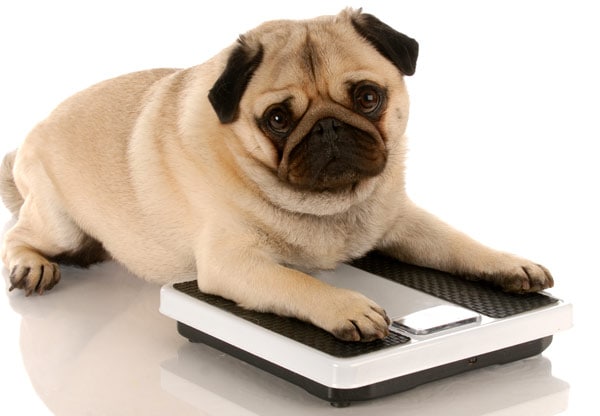
There are many reasons why providing the right amount of exercise is essential for a happy, healthy dog. Here are some of the most important:
- Lowers the Chance of Obesity. Obesity isn’t just a growing problem for humans – it’s affecting an increasing number of dogs too. Even moderate obesity can reduce the lifespan of your pet. This is because it can cause chronic inflammation, digestive problems, skin disorders, and even cancer. “A study by Purina has shown that maintaining a lean body condition score (the pet version of BMI) can not only prolong life, but also improve their quality of life,” says Dr Linda Simon, veterinary surgeon. “Using exercise to keep your dog slim is one of the best things you can do for your dog. Sadly, I see far too many obese dogs, and there is no doubt they suffer from more medical issues than their slim peers.”
- Improves Physical Condition. Just like humans, dogs need regular exercise to maintain lean muscle and bone strength. Canines are active animals – especially as many breeds were bred for high activity levels.
- Reduces Destructive Behaviors. If your dog chews, scratches, barks excessively or shows other unwanted behaviors, they might not be getting enough exercise. Dogs that can’t burn energy on a walk may resort to alternative methods! This isn’t always the case though, as sometimes being overtired or overstimulated can cause similar behaviors, so it’s important to discuss any issues with a canine behaviorist.
- Prevents Boredom. A bored dog isn’t just more likely to be destructive – they are also likely to be less happy and fulfilled. Garden time and indoor play can help, but nothing is a substitute for a proper walk.
- Provides Challenging Training Opportunities. Walking is a great time to practice training. The outdoors provides smells and other distractions for a dog, so it’s a more challenging environment for training. Outdoor training sessions are also great for mental stimulation.
- May Help Prevent Arthritis. A sedentary lifestyle causes muscle and other important tissue to degenerate. It also encourages the development of adipose tissue (fat), which can cause inflammation. For this reason, exercise is important even for dogs that are at risk of arthritis – although you need to be careful about the amount and type of exercise. “I often see muscle atrophy and unwanted weight loss in older, arthritic dogs when owners stop exercise altogether,” says Dr Simon. “Rather than halting physical activity, owners should offer consistent (but safe) daily walks to keep joints supple and prevent muscle wastage in senior pets.”
Dog walking isn’t just great for your pet. A study in the Journal of Physical Activity and Health found dog owners are up to 34% more likely to meet minimum requirements for exercise. The researchers even found people with dogs get more exercise that isn’t dog walking.
It wasn’t all good news though. The study showed a large percentage of dog owners – around 39% – didn’t walk their dogs for more than 10 minutes at a time. For most pets (or humans), this simply isn’t enough.
Some Terrifying Stats…
Up to
53.9%
of Dogs Seen by Vets in the US are Overweight*
It’s Estimated That
8.3 million
Dogs in the US are Clinically Obese*
Overweight Dogs May Live Up To
1.8 Years
Less Than Dogs With a Healthy Weight**
* Based on data from the Association for Pet Obesity Prevention 2016 survey. ** According to the Purina Lifespan Study
Why Mental Stimulation Isn’t the Same as Physical Exercise
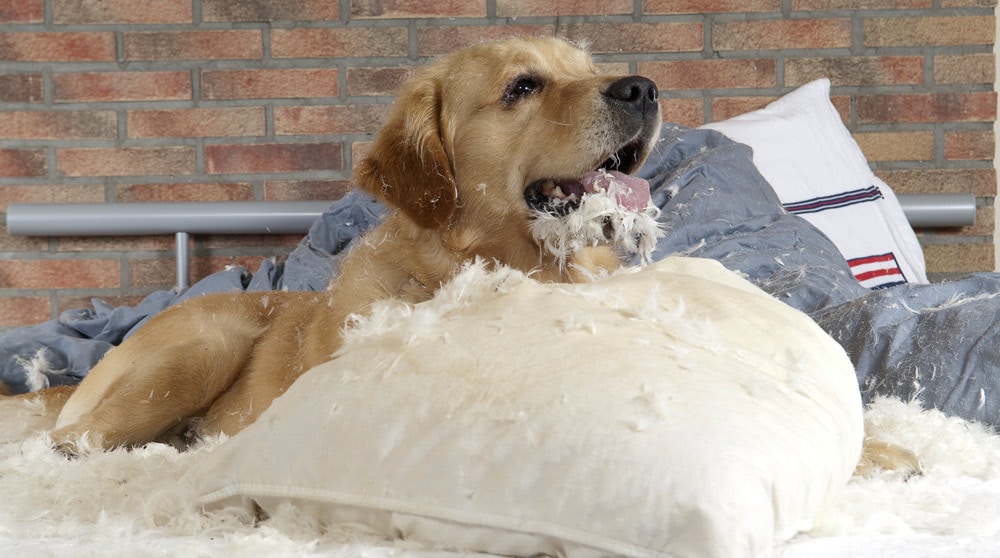
It’s important for dogs to get both mental and physical stimulation on a daily basis. This prevents boredom and reduces destructive behavior.
Luckily, many forms of exercise provide mental stimulation. For example, going on a leisurely stroll gives your dog plenty of chance to sniff new smells and meet other dogs. Canine agility classes are also great for mental stimulation, as your dog needs to listen to cues while navigating obstacles.
This isn’t the case for all activities though. For example, playing fetch is great for burning energy, but it doesn’t provide a mental challenge.
This is another reason why spending time in the yard isn’t a substitute for exercise. While your dog might have space to exercise, there are no new smells or places to explore.
“Some great examples of mentally stimulating activities that I recommend to owners include lick mats, Kong toys (or other puzzle toys), scenting games, and recall training,” says Dr Simon. “Mental stimulation that incorporates physical activity is a win-win, and I find that dogs who get enough mental and physical stimulation tend to be calmer and more confident.”
A Guide to the Perfect Walk
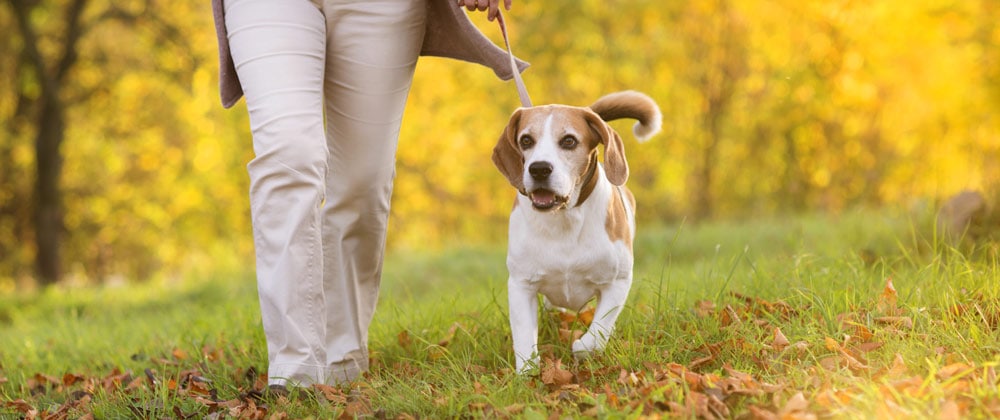
One of the best things about owning a dog is the extra motivation to get fresh air and exercise. Sometimes walking can seem like a chore – especially after a long day at work. But even a short jaunt around the block can improve your mood and energy levels.
Many dog owners don’t make the most of walks though. The result is that walks aren’t as enjoyable as they could be for either you or your pet.
This is partly because dogs and owners have different goals for walks. Dogs enjoy exploring a new environment (usually with their nose), socializing, and burning energy. Owners want to provide a chance for the dog to go to the toilet, physical exercise, mental stimulation, and training.
“There’s a misconception that just walking from A to B is enough to give a dog exercise,” says Dr Simon. “It is much more important for dogs to sniff and explore on their walks, and we should focus less on the distance covered and more on the enrichment provided.”
There is some overlap between the two sets of goals, but it’s important that all are provided on a dog walk. Here are some tips for achieving this:
- Plan a route that allows for time off-leash (if possible). Not all dogs are suitable for off-leash walking. For those that are, try to plan routes that allow for at least some time off-leash. Dogs tend to sniff and explore more when given extra freedom, which provides extra mental stimulation. Be careful if your dog is off-leash around children though – and never let them out of your sight. It’s also vital to have a reliable recall if your dog is off-leash.
- Give your dog plenty of time to sniff. Even if your dog isn’t off-leash, give them lots of opportunities to sniff and investigate. Dogs rely on their sense of smell much more than humans, so this provides lots of mental stimulation.
- Develop a routine. Shorter daily walks are much better than a single longer walk every few days. Walking each day stops your dog from getting bored and can prevent loss of muscle tone.
- Vary your walks (unless your dog prefers familiar walks). Many dogs start to get bored if they walk the same route each day. Repetitive routes are better than no exercise, but they don’t provide as much mental stimulation. For this reason, try to vary your walks. You’ll find it more interesting too! The exception is for anxious dogs, who may prefer familiar walks.
- Use a Harness. We recommend using a harness rather than a flat collar. Flat collars can cause damage to the trachea, neck, and back if your dog pulls.
- Plan varied routes. The ideal walking route provides different types of stimulation. Aside from plenty of undergrowth or bushes to sniff, a good route also has a large area for fetch or free running.
Safety When Exercising
Making sure your dog gets enough exercise is vital – but so is making sure your pup stays safe. Here are some important things to remember when walking or exercising your dog.
Weather Conditions (Hot or Cold)
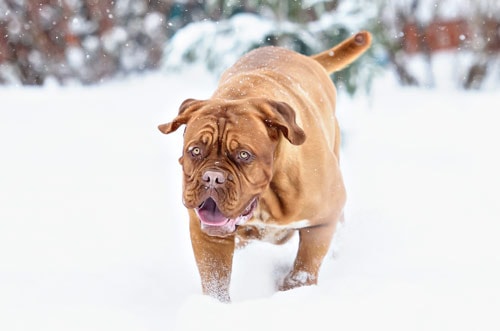
It may not be safe to walk your dog in extremely hot weather. Dogs can suffer from heat exhaustion when walking in hot temperatures, which can be fatal. This is most common in older dogs, puppies, or those with dark coats – but it can happen to any dog.
In hot conditions, either shorten the walk or use indoor forms of mental and physical stimulation. Try to walk in the early morning or evening when temperatures are lower. You may also want to read our guide to keeping dogs cool in the summer.
Cold weather can also be dangerous, so be careful when walking in the snow or below freezing temperatures. Dogs with short coats, such as greyhounds, can find cold conditions particularly difficult.
Like hot conditions, shorten walks in cold weather. Salted streets can cause burns to paw pads, so dog boots are essential for walking on pavements. It’s also important to wash the pads with warm water after each walk, as rock salt can cause salt toxicity if ingested. Dog sweaters can keep your dog at a more comfortable temperature in the cold.
Dehydration
Just like humans, one of the biggest dangers for dogs when exercising is dehydration. For this reason, make sure you always bring water with you on a long walk – even if you don’t think you’ll need it.
“I’m a big fan of portable canine water bottles with built-in bowls, as these make it easy to offer your dog a drink whenever they need one,” adds Dr Simon.
The amount of water your dog needs depends on their size. Larger dogs need more water, but the quantity depends on the level of activity, temperature and length of walk.
You don’t want to give your dog too much water though. Over-hydration can cause nausea and vomiting – especially on a strenuous walk. That’s why it’s best to provide small amounts of water on a regular basis when walking.
Never Exercise After Food (Bloat)
Gastric dilatation and volvulus (otherwise known as “bloat”) is a serious condition that can cause death in dogs. When a dog has bloat, the stomach twists before filling up with gas. This can affect breathing and blood flow to the heart, and can even lead to stomach rupture.
There are a number of potential causes of bloat, but one is exercising after eating large amounts of food.
For this reason, do not allow your dog to exercise (including playing with another dog) for at least two hours after a meal.
The symptoms of bloat are a swollen stomach, panting, drooling and pacing. Some dogs will also whimper or make other sounds that indicate pain. Vomiting without bringing anything up is another common symptom.
If you think your dog has bloat, you must visit a vet immediately – even if it’s the middle of the night and you need to pay for an emergency appointment. You can’t do anything to help at home, as surgery is the only option. If left untreated bloat is almost always fatal, so don’t take any chances.
Increase Visibility
If you walk after dusk, it’s important for your dog to wear a reflective harness or collar. This makes it much easier for cars to see him. For extra visibility, you can even get collars with LED lights.
Make sure you’re wearing reflective clothing too!
Don’t Throw Sticks
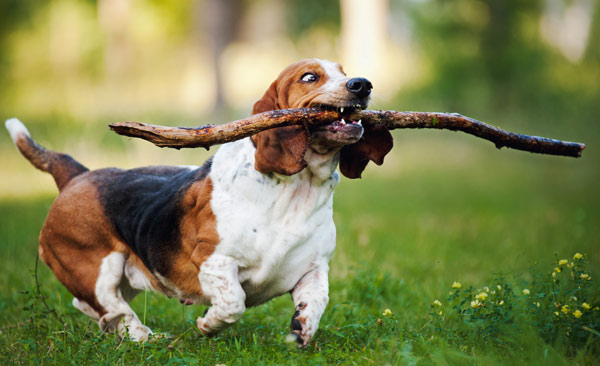
Throwing sticks can be very dangerous for dogs, as they can splinter and even cause severe puncture wounds.
“I’ve seen several cases of large sticks impaling inside a dog’s mouth,” says Dr Simon. “This can cause large and painful holes which quickly become infected.”
For this reason, we always recommend using a dog ball instead of a stick. Ensure the ball is too big to fit down your dog’s throat, otherwise they might accidentally swallow it.
Protect Your Dog’s Joints
It’s important to protect your dog’s shoulder, knee, and hip joints as much as possible. This can reduce the chance of arthritis later in life.
Exercising on soft ground is almost always better for a dog’s joints. Avoid activities that force your dog to jump off objects, as this puts excessive strain on the joints.
Fun Ways to Exercise Your Dog
Most of your dog’s exercise is likely to come from daily walks. But there are plenty of other fun ways to provide exercise and mental stimulation.
| Ball Throwing Fetch provides intense aerobic exercise – although it should only be played occasionally and in moderation. Make sure the ball isn’t too small, as it can be a choking hazard. There’s also flyball, which is a competitive version of ball catching with many local clubs. | Canicross Canicross is cross-country jogging with a dog. Some owners also teach voice cues for direction, so it provides mental stimulation. |
| Canine Agility Agility classes combine physical exercise with mental stimulation. They are also great for bonding with your pet. | Swimming Swimming is low-impact, so it can be great for dogs with joint pain. Dry your dog quickly after swimming to keep them warm though, and always ensure they are wearing a life jacket. Keep sessions short. |
| Tracking Rub a favorite toy on the floor at regular intervals, then hide it at the end. Get your dog to sniff it out with a treat as a reward. | Socializing Many dogs love to meet either humans or dogs (or both!) This means socializing is great for preventing boredom. |
| Treadmill Treadmills can be useful for high-energy dogs or rehabilitation. They require special training though – and can’t substitute a walk. | Cue Training Cue training builds a stronger bond with your dog and provides mental stimulation. It’s best in short sessions though. |
Are There Types of Exercise You Should Avoid?
Many dogs will exercise to the point of exhaustion or heat stroke. For example, running or cycling with dogs can be very dangerous, as the dog will push through exhaustion to avoid being left behind.
For this reason, we don’t recommend jogging or cycling with your dog. It’s safest to keep your cardiovascular exercise separate from your dog’s walks. Even when walking, never force your dog to keep up with you – always go at a pace that’s comfortable for them.
Make sure you build up a new exercise routine slowly. Keep a close eye on your dog and watch for symptoms of tiredness, panting, drooling, or a loss of coordination. If your dog starts to slow down, stop immediately and give a drink.
Indoor Games for Mental Stimulation
Indoor games are great for providing extra mental stimulation. They are particularly useful for older dogs or when weather conditions don’t allow for a full walk.
Some of our top recommendations include:
- Food-Stuffed Toys. Nothing gets most dogs excited like a Kong filled with peanut butter. The challenge of getting every last drop provides plenty of mental stimulation. Some people go a step further and feed their dog meals using a food dispensing toy.
- Hide and Seek. Show a toy to your dog then ask him to wait. Hide the toy somewhere in the house and get him to find it. Dogs love using their sense of smell for games – especially if they get a treat as a reward (just don’t over-do the treats!)
- Tug of War. This classic doggy game is great for providing a physical challenge without leaving the house. Stop before your dog gets over-stimulated though. This game is also useful for teaching the “give” cue.
- Shell Game. Take two plastic cups and turn them over. Make sure you have your dog’s attention, then put a treat under one of the cups. On your cue, let your dog touch one of the cups. If they get it right, give them the treat. If they get it wrong, show the mistake but don’t give the treat. Dogs tend to find this very challenging to begin with – but they’ll quickly learn and it provides great mental stimulation. Once your dog finds it too easy, start moving the cups around after you place the treat.
- Trick Training. Learning a new trick requires lots of concentration and brain power. It’s also a fun way for you to bond with your dog.
For more ideas, take a look at our guide to the best indoor games for dogs.
Useful Tools
- Portable Pet Water Carrier With Bowl. Carrying water is essential when on long walks. A portable water carrier that converts into a fold-out bowl is much more convenient than a separate bottle and bowl.
- Dog Booties. Dogs have tough paw pads, but they can still be hurt by hot pavements, salt and sharp rocks. A pair of boots can protect paws without limiting movement (check out our page of the best boots for dogs for more information).
- High-Quality Reflective Harness. Harnesses are a safer choice for walking. They spread force across the shoulders and chest, rather than concentrating it on the neck. It’s vital to buy a tough, durable, and high-quality harness, though – and it should have reflective strips if you walk after dusk. Take a look at our page of the best dog harnesses for an in-depth guide to choosing the right one for your pet.
- Food-hiding Toy. One of the easiest ways to provide mental stimulation at home is with a food-hiding toy. Kong is the most popular brand, but there are plenty of great alternatives.
Summary
Regular exercise is essential for any dog’s health and mental well-being. A lack of exercise can contribute to destructive behavior, obesity, boredom, and a variety of health problems. Dogs also need continuous mental stimulation with new smells and sights – so spending time in the yard isn’t a substitute.
The key is to adapt exercise to your dog. Every dog is different, so you need to consider their needs and capabilities. Providing variety in your walks and mental stimulation is also essential.
It’s important not to overdo it though. While it’s great to be passionate about keeping your dog fit, make sure you provide an appropriate amount of exercise for your pet’s breed, age, health, and personality.
Most importantly, have fun when walking your dog! Exploring the local countryside or parks is one of the great joys of having a dog, so make the most of it.
Do you have any questions about your dog and exercise? Or do you want to give feedback on the article? Let me know in the comments section! You may also want to read our guide to mental stimulation in dogs.
Sources
- http://healthland.time.com/2011/03/16/cue-the-canine-dog-walkers-are-more-likely-to-reach-fitness-goals-study-says/
- http://www.vetstreet.com/our-pet-experts/your-dog-why-exercise-is-important
- https://www.petobesityprevention.org/2016-
- https://www.purina.ca/articles/dog/health/landmark-life-span-study-in-dogs
- https://animalwellnessmagazine.com/importance-of-exercise-dog/
- http://www.akc.org/content/dog-care/articles/how-much-exercise-does-dog-need/
- https://www.thekennelclub.org.uk/getting-a-dog-or-puppy/general-advice-about-caring-for-your-new-puppy-or-dog/puppy-and-dog-walking/
- https://www.seniortailwaggers.com/exercising-older-dogs/
- https://www.pdsa.org.uk/taking-care-of-your-pet/looking-after-your-pet/puppies-dogs/how-much-exercise-does-your-dog-need
- https://www.petcha.com/dog-walking-by-the-numbers/
- http://healthypets.mercola.com/sites/healthypets/archive/2011/05/19/walking-your-dog-how-to-do-it-well-and-why-its-so-important.aspx
- https://cani-fit.com/beginners-guide-to-canicross-2/
- http://www.petmd.com/dog/conditions/digestive/signs-and-symptoms-bloat-dogs
- https://countrysideveterinary.net/large-dog-shouldnt-run-play-after-eating/

This was extremely helpful. As a beginner dog walker, I needed confirmation on what I was observing!!!! I own a 5 yr old micro mini dachshund and we live with a 12 yr.old boxer/great Dane mix and a 10 yr old husky/?? mix. The “big guys” were getting little to no exercise when I started walking them (about 2 weeks ago) so I knew to start slow and walk them separately. After a couple of walks I decided the boxer mix and my dachshund had similar walking habits as and started walking them together, then walk the husky mix alone. Although I’ve been taking the same route for all walks, the husky mix gets better quality walks because he’s alone and tends not to have to stop and sniff as often as the older dog and the smaller dog.
Glad it helped Melanie! Good luck with your walks – it sounds like you’ve got a good system going 🙂
I found this a very useful article – thank you! I live in Brunei (Borneo) and have two ‘kampong’ dogs (village, or street dogs) who were rescued as pups by their previous owners. They are now four years old, about Labrador sized and have wonderful temperaments. I take them for walks on our local jungle trails every day (unless there’s a tropical downpour), and they love it. They are off-lead and go crashing through the undergrowth and up and down steep hills with gusto. I just hope it’s lizards they’re chasing and not snakes! They never catch anything, so I don’t think it’s a big issue. We also take them to the beach at weekends, which is flat and offers a different walking experience.
Sometimes it does get very hot and humid here, so after reading your article I am going to be more careful not to overdo the walks in hot weather; sometimes they are very hot when we get home, and I don’t want to put them at risk, so thanks again! 🙂
Hi Gary, thanks for your comment and I’m glad you found the article useful. Sounds like you’ve got a couple of wonderful dogs!